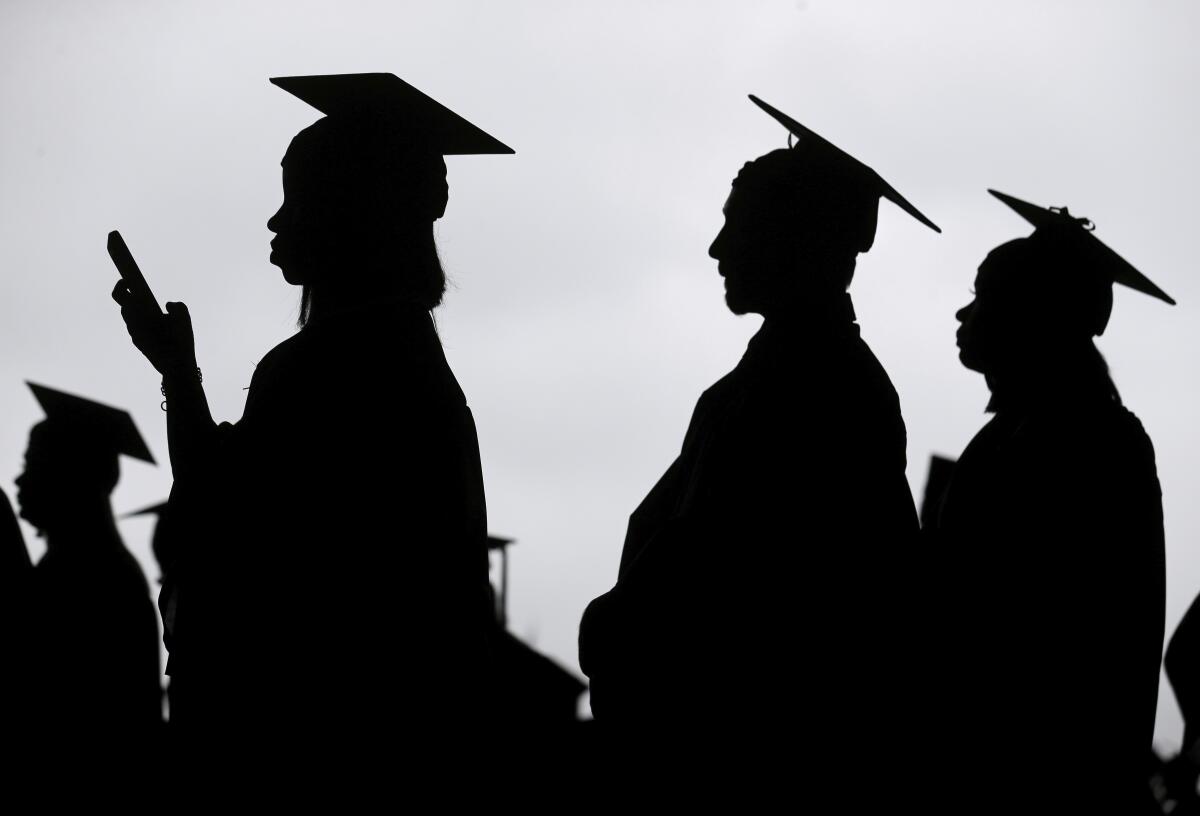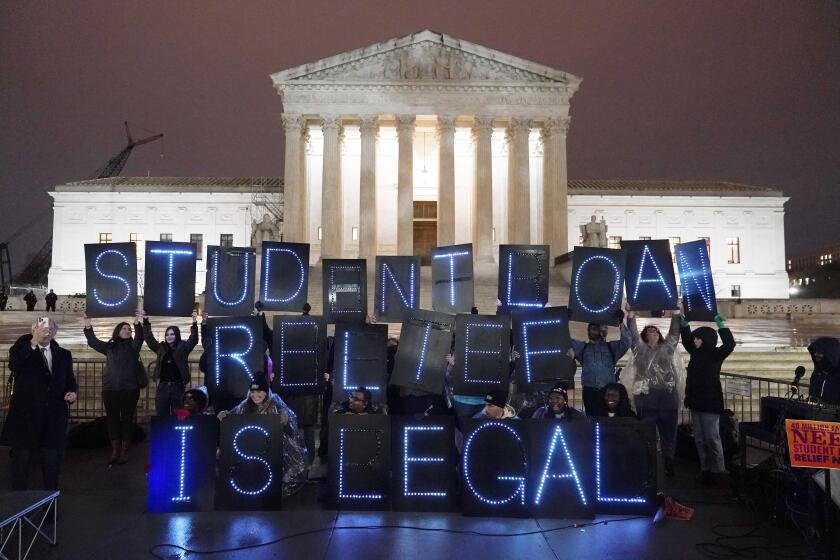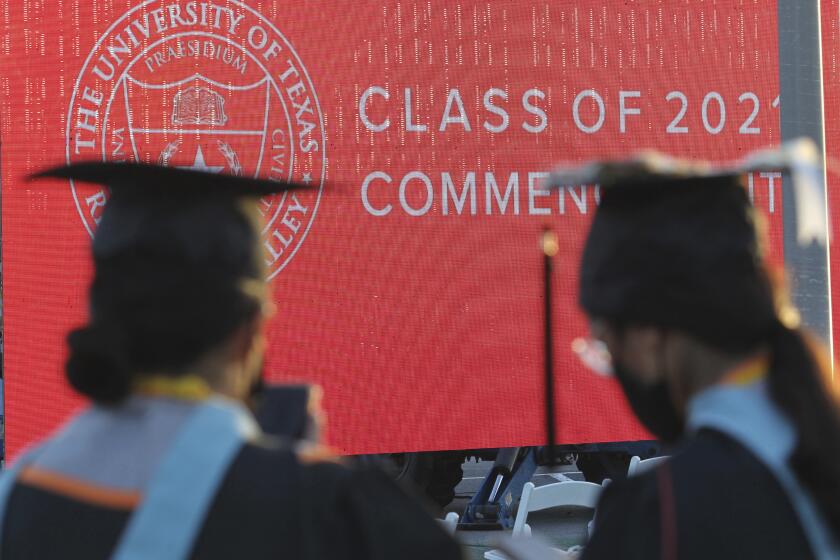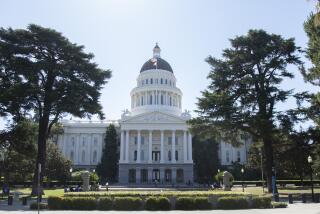Californians, your forgiven student loans may come with a tax bill. Here are the details

Millions of Californians got a long-awaited financial boost last month when the Biden administration announced that it would cancel up to $20,000 in federal student debt for low- and moderate-income borrowers.
But California tax policy could throw a wet blanket over the party. That’s because the loan forgiveness may be taxable under current state rules, even though it’s tax-free under federal law.
Two top state officials pledged Friday to address the issue promptly and ensure that borrowers pay no state taxes on their debt relief.
Federal and state tax laws generally classify any debts that are forgiven as income unless the borrowers are bankrupt. There are multiple exceptions, however, and the federal government added another one in the 2021 American Rescue Plan Act. That law exempted student loans (and parent loans) forgiven by the end of 2025.
California, however, did not change its tax law to conform with that provision, Kathryn Zdan, editorial director of Spidell Publishing, said in a podcast last week. So unless you qualify for one of a handful of exceptions, you may have to treat the amount of debt forgiven under the new Biden initiative as income subject to state taxes.
Ouch.
The federal government plans to forgive up to $20,000 in student loan debt for millions of Americans. Here’s everything you need to know.
The Franchise Tax Board isn’t offering any clear guidance on the issue yet, telling borrowers in essence to stay tuned.
“To answer your question about whether the forgiven federal student loan debt announced last month will be taxable for California, we would need to know whether the U.S. Department of Education will administer the program under Section 1098e of Title 20 of the United States Code, or use some other method,” the board said in an emailed statement.
If the debt is forgiven through some other section of the law, the board said, it will be taxable in California.
Section 1098e of Title 20 governs the Education Department’s income-based loan repayment plans, which cancel a borrower’s remaining debt after up to 25 years’ worth of monthly payments. Under state law, student loan debt canceled that way is not taxable in California.
The federal Department of Education itself is remaining mum on the issue, saying more details will be forthcoming. Borrowers should keep an eye on the department’s loan-forgiveness page and sign up to receive updates via text.
Rep. Eric Swalwell of the Bay Area has spent years pushing legislation to forgive student loan interest and set rates to zero.
Several tax and student loan experts said they were skeptical that the relief will be tax-free in California.
The nonprofit Tax Foundation stated flatly that the state’s exemptions wouldn’t apply in this case. Mike Pierce, executive director of the Student Borrower Protection Center, said in an email that “mechanically, the discharge of these loans will not be via Income-Based Repayment.”
John Brooks, a Fordham University law school professor who specializes in student loan issues, agreed. “To be clear, this $10k/$20k debt cancellation is not being done under 1098e or any of the [income-driven repayment] provisions,” Brooks said in an email. So far, he added, the department is “not even citing the Higher Education Act at all, and using provisions of the HEROES Act of 2003 instead.”
The state exempts canceled debts from income tax in the case of insolvent or bankrupt residents, or for borrowers who complete income-based repayment plans, who die or become disabled, or who fulfill the conditions of a public service loan. The Biden administration’s across-the-board forgiveness fits none of those categories.
The White House said Pell Grant recipients would receive twice as much loan forgiveness as other low- and moderate-income borrowers. Do you qualify? Check the Federal Student Aid website.
Responding to an earlier version of this article, state Assembly Speaker Anthony Rendon (D-Lakewood) and Senate President Pro Tem Toni Atkins (D-San Diego) tweeted: “Once the federal government finalizes details of the student debt relief program, we will know whether the relief is tax exempt under current California law. If not, we will make the relief tax exempt through immediate action in early 2023. Rest assured, one way or another, California will not tax the federal student debt relief.”
In any case, the federal government won’t be helping states like California collect taxes on the forgiven loans, Brooks said.
“The IRS has directed [the Education Department] and other loan holders not to issue 1099s to any borrowers with canceled debt,” Brooks said, referring to an IRS form that reports income received by a taxpayer. “That means it may be hard for California and other states to enforce this — I suspect many borrowers won’t even realize there is a tax issue here at all if they don’t receive a 1099.”
If you do have to pay taxes on the forgiven amount, how much you’ll owe will depend on your income when the debt is forgiven. According to Natalia Abrams, president of the Student Debt Crisis Center, the Education Department has told borrowers that the forgiveness would be applied by the end of this year.
The administration plans to forgive up to $10,000 in federal student loan debt for single borrowers earning less than $125,000 a year or couples earning less than $250,000. The amount would rise to $20,000 for borrowers who received Pell Grants and who meet the income limits.
For single individuals earning less than $125,000, the state’s tax rates for 2021 started at 1% (for people with up to $9,325 in taxable income) and rose to 9.3% (for amounts above $61,215). For couples filing jointly, the thresholds for each brackets were twice the amounts for single taxpayers.
The brackets will change for 2022 because of inflation. Nevertheless, a single taxpayer earning the median income in Los Angeles County — about $64,000 — could expect to pay roughly $800 in taxes on $10,000 in loan forgiveness, and roughly $1,600 on $20,000 in loan forgiveness.
President Biden’s loan forgiveness plan papered over some of the financial aid complexities. Here’s how to figure out if your loan may be eligible.
For many California borrowers, the amount saved through the loan forgiveness program will greatly exceed the state taxes they may have to pay. But borrowers in income-based repayment plans can pay as little as $0 per month if their incomes are low enough. The same is true for borrowers in the Public Service Loan Forgiveness program, who could conceivably pay more in taxes on the forgiven amount than they would save in monthly payments. Borrowers in those scenarios may want to forgo the debt relief to avoid the tax bill.
It’s not clear, however, whether they will have a choice. The Education Department has said that it will grant the debt relief automatically to about 8 million qualified borrowers whose income data are on file, with the rest having to apply for loan forgiveness.
It’s also possible that the state will exempt the new round of debt relief before taxes become due, as Rendon and Atkins pledged Friday. A number of states have already conformed their tax laws to the federal rules, meaning their residents won’t pay federal or state taxes on their forgiven loans.
About The Times Utility Journalism Team
This article is from The Times’ Utility Journalism Team. Our mission is to be essential to the lives of Southern Californians by publishing information that solves problems, answers questions and helps with decision making. We serve audiences in and around Los Angeles — including current Times subscribers and diverse communities that haven’t historically had their needs met by our coverage.
How can we be useful to you and your community? Email utility (at) latimes.com or one of our journalists: Jon Healey, Ada Tseng, Jessica Roy and Karen Garcia.
More to Read
Sign up for Essential California
The most important California stories and recommendations in your inbox every morning.
You may occasionally receive promotional content from the Los Angeles Times.















